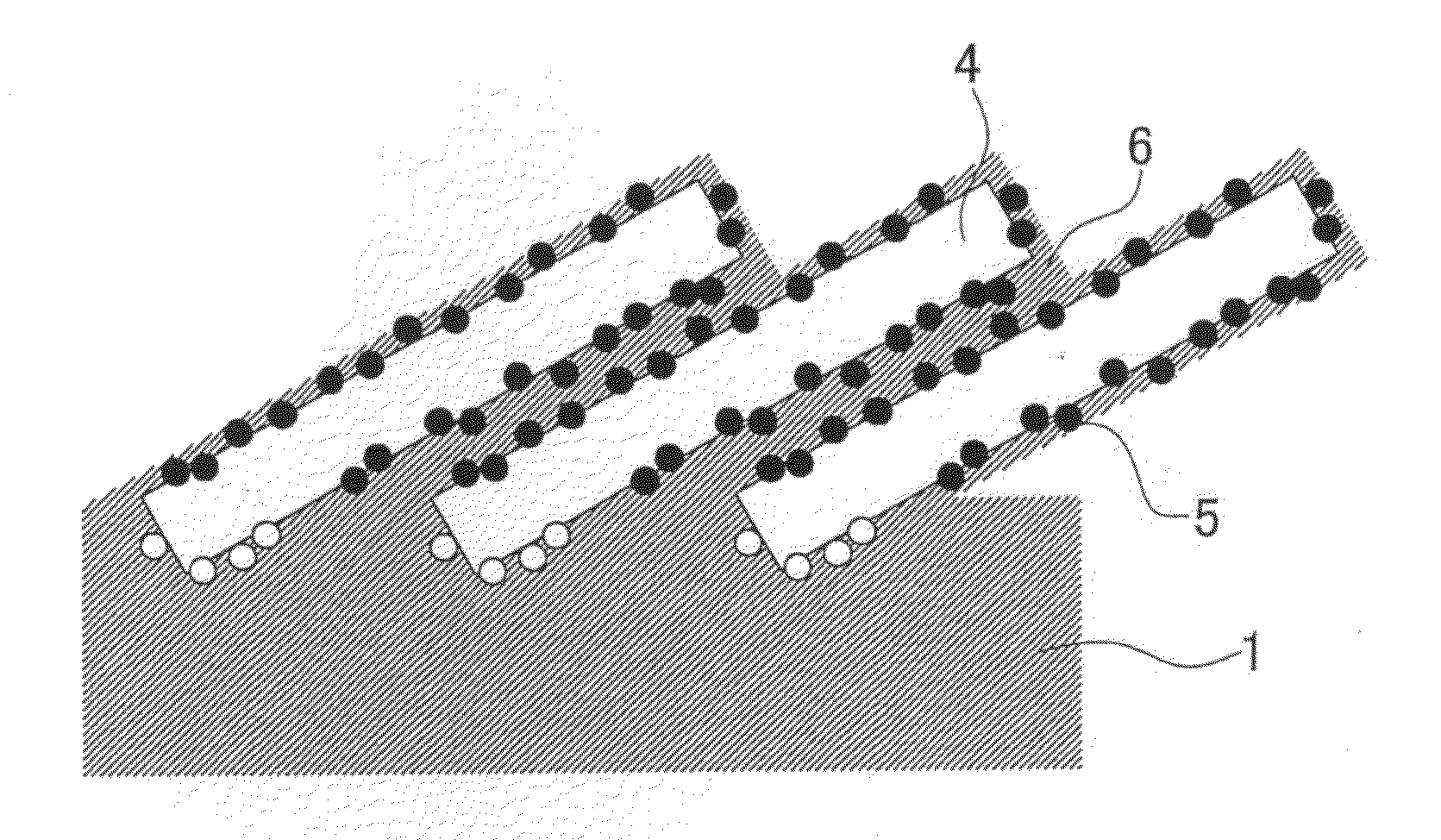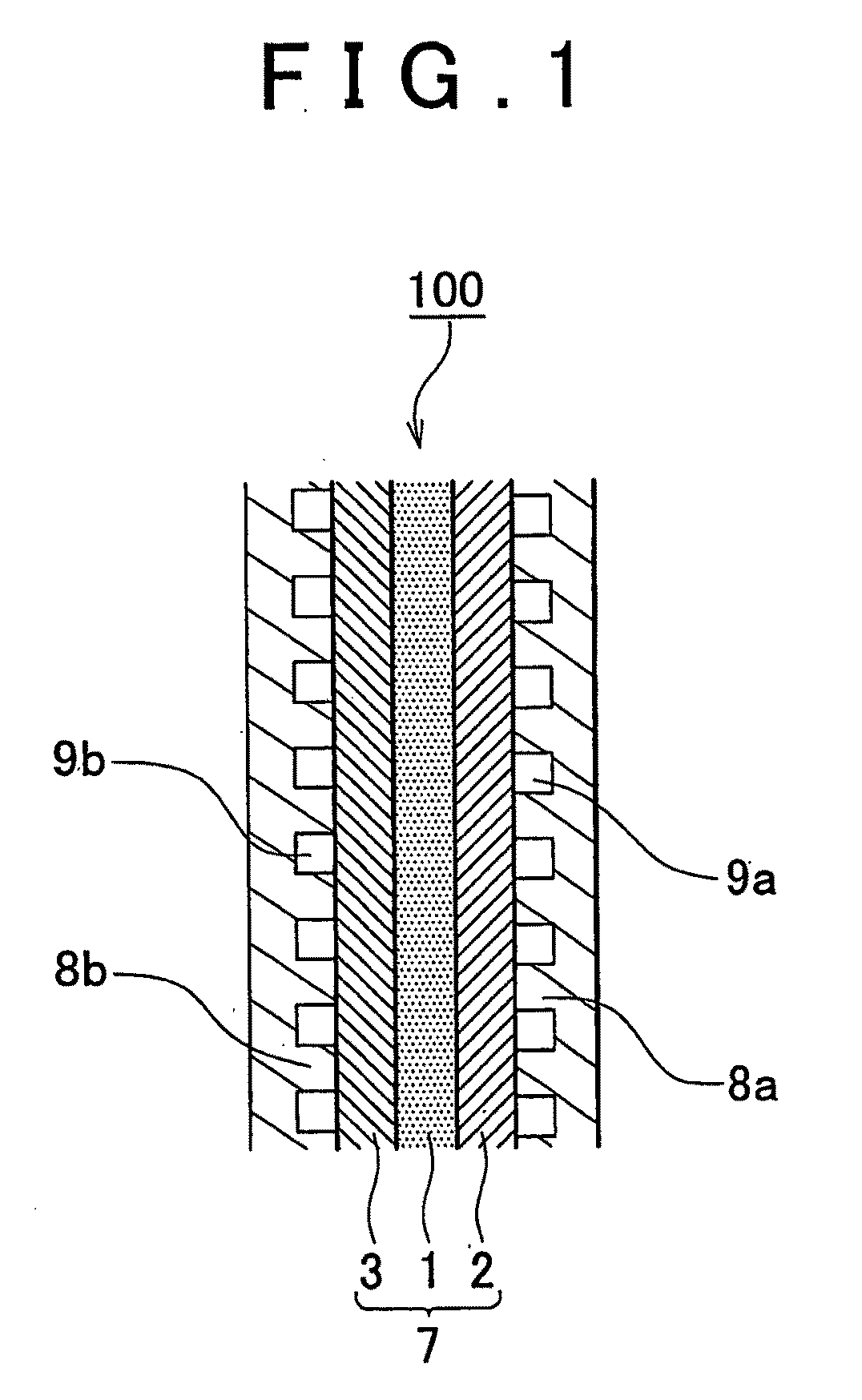Fuel cell with electrode having an electrically conductive nano-column and production method thereof
a fuel cell and nano-column technology, which is applied in the manufacture of cell components, final product manufacturing, electrochemical generators, etc., can solve the problems of catalyst utilization efficiency decline, performance ceiling, and increase in fuel cell production cost, so as to improve fuel cell power generation efficiency per unit volume and power generation efficiency per unit weight of the catalys
- Summary
- Abstract
- Description
- Claims
- Application Information
AI Technical Summary
Benefits of technology
Problems solved by technology
Method used
Image
Examples
example 1
[0071]Firstly, a thin iron membrane having a thickness of 5 nm was formed on a silicon substrate of 50 mm×50 mm by the electron beam evaporation method, and then the silicon substrate was placed in a quartz reaction tube having an inside diameter of 50 mm. Next, a helium gas was caused to flow into the quartz reaction tube at a rate of 200 ml / min, and the temperature was raised to 730° C.
[0072]
[0073]After the temperature of the quartz reaction tube reached 730° C., an acetylene gas was caused to flow at a rate of 30 ml / min for 10 minutes together with the helium gas (200 ml / min). Subsequently, the inflow of the acetylene gas was stopped, and the quartz reaction tube was cooled to normal temperature. This operation produced carbon nanotubes (CNTs) that were oriented substantially vertically on the silicon substrate. The obtained carbon nanotubes had a weight per unit area of the silicon substrate of 0.2 mg / cm2, and a length of 40 μm. Observation through a transmission electron micros...
example 2
[0081]
[0082]These steps are the same as in Example 1.
[0083]
[0084]A platinum salt solution having a platinum concentration of 30 g / l was prepared by dissolving a chloroplatinic acid in isopropanol. While the substrate was placed so that the surface having the carbon nanotubes faced upward, 200 μl of the platinum salt solution was dropped so that the amount of the platinum salt solution per unit area of the silicon substrate became uniform (about 8 μl / cm2). Subsequently, a heat treatment was performed at 320° C. for 2 hours in a 4% hydrogen (diluted with an argon gas) atmosphere. An electrode precursor in which 0.24 mg / cm2 of a platinum catalyst was supported on the carbon nanotubes oriented vertically on the silicon substrate was obtained.
[0085]
[0086]Using the electrode precursor obtained in Step 3, a membrane-electrode assembly was obtained in substantially the same manner as in Example 1. The conditions of creation of the membrane-electrode assembly, the weight of the carbon nanotu...
examples 3 to 7
[0087]
[0088]These steps are the same as in Example 1.
[0089]
[0090]A membrane-electrode assembly was obtained in substantially the same manner as in Example 1, except that the thermal transfer condition was changed as shown in Table 1.
[0091]The inclination angle of the carbon nanotubes of each membrane-electrode assembly is shown in Table 1. From Table 1, it can be seen that in conjunction with the thermal transfer of the carbon nanotubes from the silicon substrate where the carbon nanotubes are vertically oriented to the electrolyte membrane, the inclination angle of the carbon nanotubes becomes smaller if the heating temperature is made higher or the applied pressure is made higher or the transfer time is made longer. It also can be seen that in the case where the perfluorocarbon sulfonic acid resin is used as the electrolyte membrane and the electrolyte resin, the inclination angle of the carbon nanotube with respect to the planar direction of the electrolyte membrane can be made l...
PUM
 Login to View More
Login to View More Abstract
Description
Claims
Application Information
 Login to View More
Login to View More - R&D
- Intellectual Property
- Life Sciences
- Materials
- Tech Scout
- Unparalleled Data Quality
- Higher Quality Content
- 60% Fewer Hallucinations
Browse by: Latest US Patents, China's latest patents, Technical Efficacy Thesaurus, Application Domain, Technology Topic, Popular Technical Reports.
© 2025 PatSnap. All rights reserved.Legal|Privacy policy|Modern Slavery Act Transparency Statement|Sitemap|About US| Contact US: help@patsnap.com



